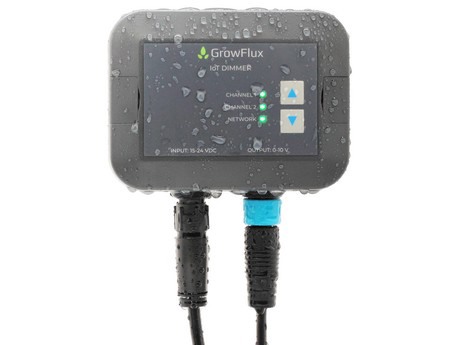When controlling light levels in a greenhouse, is there better way than simply turning the lights on when clouds roll in and off when sunlight returns? GrowFlux, a Philadelphia-based manufacturer of lighting control systems, believes so. After getting its start as a lighting manufacturer in 2015, GrowFlux decided to shift its attention away from lights and turn its competitors into collaborators by manufacturing sleek and user-friendly lighting controls. Eric Eisele, CEO of GrowFlux, explained that the company develops lighting control systems that “work out of the box with many lights on the market. The company’s lighting controls feature easy to use interfaces, Android/IOS smartphone apps, and a software API for advanced users. GrowFlux works with both growers and lighting manufacturers to develop new control schemes and integrate its wireless controls with a range of lights. In 2020, GrowFlux is now able to tightly integrate its user experience and control schemes with commercially available lights and has recently partnered with lighting manufacturer XtraLight to do exactly that.
The company’s flagship product is the GrowFlux Dimmer, a commercial wireless lighting controller which enables precision software based scheduling and dimming of LED and HPS lighting controlling up to 50 fixtures on a single dimmer.

Eisele explained LEDs are infinitely dimmable and can be turned on and off an unlimited number of times without lifetime degradation, unlike HPS lighting. That matters because bringing software based control to LED lights enables significant energy savings and advanced control capabilities where lighting systems can be made responsive to environmental conditions or energy pricing data in real time. “We spend a lot of time making our apps and software easy to use,” says Eisele, who explained that growers are most often reluctant to use new technology in farms due to the level of complexity it typically adds to the operation.
According to Eisele, wireless controls can also provide significant cost savings to the client and many of the greenhouses equipped with GrowFlux solutions have reduced capital costs by eliminating switch panels typically used to switch lights on and off.
“[GrowFlux’s developments] would not have been possible without close collaboration with growers,” according to Eisele, who is also feeling the strain of not being able to visit growers due to the COVID-19 pandemic. GrowFlux is always looking to work with customers who have unique challenges in the horticultural lighting sphere.
For more information:
GrowFlux
[email protected]
www.growflux.com
